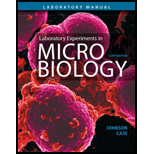
Concept explainers
What was the antiserum used in this experiment?
To fill:
Patient's serum
Introduction:
Agglutination is the phenomenon by which the antibody gets clumped to the antigenic components like flagellum, cell walls or capsules that are found on the cells of the bacterium. An unknown bacterium is usually mixed in saline and taken in a slide and antiserum containing known antibodies is added. Agglutination happens if the antibodies encounter antigens of the same species or strains as that of the antibody.
Answer to Problem 1Q
The patients serum is the antiserum used in this experiment.
Explanation of Solution
In the experiment, initially patient's serum is mixed with saline and wells are labeled and then dilutions of the antiserum( patient's serum) is made .Then to it antigen was added .The endpoint or the titer is the highest dilution in which clumping has taken place clearly. The patient's serum contains antibodies to the Salmonella entericaTyphimurium if clumping is detected. If there is no clumping or agglutination ,then there are no antibodies to the above mentioned bacterium. This forms the basis for Widal test or test for diagnosis of Typhoid fever.
Want to see more full solutions like this?
Chapter 43 Solutions
Laboratory Experiments in Microbiology (12th Edition) (What's New in Microbiology)
- students in a science class investiged the conditions under which corn seeds would germinate most successfully. BAsed on the results which of these factors appears most important for successful corn seed germination.arrow_forwardI want to write the given physician orders in the kardex formarrow_forwardAmino Acid Coclow TABle 3' Gly Phe Leu (G) (F) (L) 3- Val (V) Arg (R) Ser (S) Ala (A) Lys (K) CAG G Glu Asp (E) (D) Ser (S) CCCAGUCAGUCAGUCAG 0204 C U A G C Asn (N) G 4 A AGU C GU (5) AC C UGA A G5 C CUGACUGACUGACUGAC Thr (T) Met (M) lle £€ (1) U 4 G Tyr Σε (Y) U Cys (C) C A G Trp (W) 3' U C A Leu בוט His Pro (P) ££ (H) Gin (Q) Arg 흐름 (R) (L) Start Stop 8. Transcription and Translation Practice: (Video 10-1 and 10-2) A. Below is the sense strand of a DNA gene. Using the sense strand, create the antisense DNA strand and label the 5' and 3' ends. B. Use the antisense strand that you create in part A as a template to create the mRNA transcript of the gene and label the 5' and 3' ends. C. Translate the mRNA you produced in part B into the polypeptide sequence making sure to follow all the rules of translation. 5'-AGCATGACTAATAGTTGTTGAGCTGTC-3' (sense strand) 4arrow_forward
- What is the structure and function of Eukaryotic cells, including their organelles? How are Eukaryotic cells different than Prokaryotic cells, in terms of evolution which form of the cell might have came first? How do Eukaryotic cells become malignant (cancerous)?arrow_forwardWhat are the roles of DNA and proteins inside of the cell? What are the building blocks or molecular components of the DNA and proteins? How are proteins produced within the cell? What connection is there between DNA, proteins, and the cell cycle? What is the relationship between DNA, proteins, and Cancer?arrow_forwardWhy cells go through various types of cell division and how eukaryotic cells control cell growth through the cell cycle control system?arrow_forward
 Principles Of Radiographic Imaging: An Art And A ...Health & NutritionISBN:9781337711067Author:Richard R. Carlton, Arlene M. Adler, Vesna BalacPublisher:Cengage Learning
Principles Of Radiographic Imaging: An Art And A ...Health & NutritionISBN:9781337711067Author:Richard R. Carlton, Arlene M. Adler, Vesna BalacPublisher:Cengage Learning- Essentials of Pharmacology for Health ProfessionsNursingISBN:9781305441620Author:WOODROWPublisher:CengageCase Studies In Health Information ManagementBiologyISBN:9781337676908Author:SCHNERINGPublisher:Cengage





